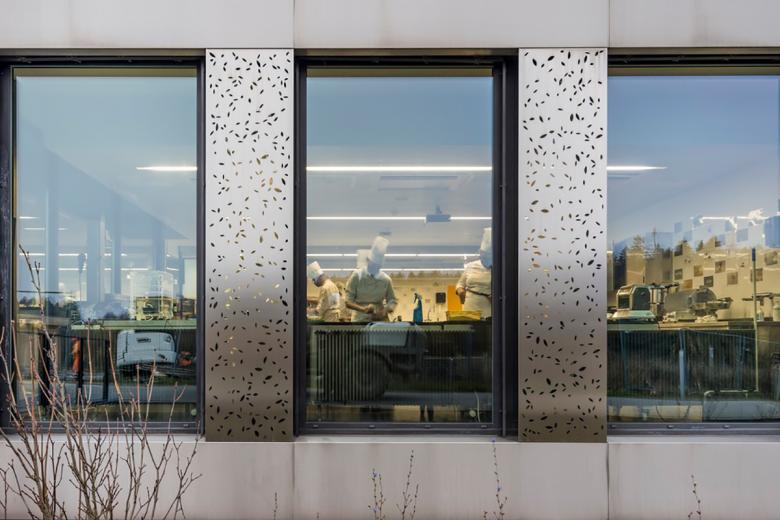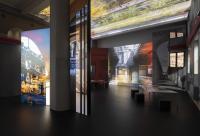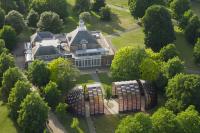Campus for the EHL Hospitality Business School
Chalet-à-Gobet, Switzerland
This ambitious project reflects the rigor and excellence that have shaped the reputation of the EHL throughout the world. The EHL has approximately 4,000 students enrolled on its three campuses in Switzerland and Singapore. Three new buildings – residential, sports, and leisure facilities – now complete the new campus situated on the heights of
Lausanne (Switzerland).
A far-reaching program in a privileged location
The campus occupies a site of around 80,000 m2, with 34,500 m2 of floor space; it currently accommodates more than 819 beds (16 m2 studios and 25 m2 bedrooms), several restaurants, teaching kitchens, sports facilities (a 25-meter swimming pool, a fitness trail, a multi-sports hall, basketball and beach volleyball courts, tennis courts, etc), a 935-space parking lot for automobiles, and a 600-space parking lot for bicycles. All this in a corner of paradise located in Chalet-à-Gobet, overlooking Lausanne.
A generous and bright welcome
The main access to the campus is now via the Route de Berne. Traffic patterns had to be reinvented, and forest mounds were built to absorb noise pollution and provide a natural barrier for campus users.
To cope with this geographical reversal, the IB office had to contend with a 10-meter difference in elevation. At the same level as the Route de Berne, a wide entrance square leads to the campus reception area, illuminated by a patio where a shadbush tree is surrounded by pools of water.
In order to reach the level of the existing academic spaces, the architects imagined a structure like a majestic staircase, composed of landings «symbolizing a form of ascent toward knowledge,» according to Laurent Gerbex and Virginie Reussner, associate architects of the IB office. This staircase-like structure is surmounted by a 3,000 m2 glass roof. «Technologically speaking, our objective has been to create a structure that can evolve over time while conforming to the values defined by EHL,» add the architects. The immense, luminous agora, to be completed this fall, will feature a high-end brasserie, a food court, meeting rooms, and study areas, becoming the link between the existing and new campuses.
At the center of the campus, a historic farmhouse has been preserved and restored to its original state. It is the guarantor of the past, a testimony to memory, both from a historical point of view and as a souvenir for students. Symbolically, just below it lies the new reception area, an open space structured by 12 loadbearing pillars which echo the contours of the farmhouse.
A campus conceived to encourage interaction
The architectural project reflects the desire to encourage social interaction and to attribute to all spaces an educational purpose. The accent is on public spaces, spaces conducive to meetings and exchanges, which are so important in the training of the EHL student.
Thus, all the campus buildings are linked by a ‘connector’, a type of platform housing the interior circulation and sports activities. Above, the buildings are organically laid out as green space.
In keeping with this idea of ‘connection’ that allows the various spaces of the campus to intersect, one place must be able to make the link with the next and ensure a kind of transition, a porosity between the different functions. A reception desk serves as a reception area for sports activities, but also as a training area. The on-site restaurant is used for training, but also for campus events. The Oak Field sports hall can be transformed into a multi-purpose hall for events hosting up to 2,000 guests.
A transparent campus
The architects took into account the expressed desire to show and expose all the activities related to the hotel operation for educational purposes. This transparency can be seen in the glazed treatment of the common spaces around the courtyard, in the views crossing between the upper and lower levels of the campus, and in the multitude of openings in the planted roof of the connector building.
This new campus is also an instrument for research in the hospitality industry. It functions as an integral part of the curriculum by putting students in context. It is equipped with rooms for culinary demonstrations, table arts, and wine tastings. An orchard planted with local and Vaudois fruit trees and a permaculture vegetable garden supply produce for everyday consumption to highlight agricultural activity and production within the EHL site.
A healthy mind in a healthy (building) body
The entire complex will be certified Minergie-P® and 58% of the carbon footprint of its construction has already been fully offset. The site is equipped with 47 geothermal probes that draw heat from a depth of 400 meters. «Heat production is (90%) ensured by 6 heat pumps: 1 for the recuperation of wastewater heat, 3 geothermal probes, and 2 that raise the low temperature (40°C) to high temperature (70°C) to produce domestic hot water. The remaining 10% of heat production is produced by 3 gas boilers,» noted Fabrice Volery, project manager at Weinmann Energies. The campus is supplied with electricity by 3,500 m2 of photovoltaic solar panels.
Three residential buildings
In order for the public spaces to act as catalysts for social interaction, it was necessary to define residential spaces of a diametrically opposed character. Bedrooms were thus conceived as bubbles of tranquility, which students are able to appropriate thanks to their pure and simple architectural lines. Here the private sphere is respected. There are 5 types of rooms. In addition to the single and double rooms that make up the vast majority of the residential units, there are three adaptable types of rooms for those with reduced mobility.
An 8.10-meter grid punctuates the 3 U-shaped residential buildings. This guarantees a flexible structure and the possibility of changing the layout of the rooms. In addition, the structure has been dimensioned so that all buildings can be expanded in the future if necessary.
The exceptional environment in which the buildings are located has drawn much attention to the relationship between the interior spaces and the immediate exterior. Each room benefits from a generous opening onto outdoor space, which is arranged in a variety of landscaped sequences with trees.
Between each wing of the 3 U-shaped buildings, there is a vast common space whose height varies from 9 to 13 meters depending on whether the building allows students to gather. These atriums are open to the Jorat forest, which slips between the buildings like an ambient landscape tableau.
- Architects
- Itten+Brechbühl AG
- Location
- Chalet-à-Gobet, Switzerland
- Year
- 2022
- Client
- EHL Real Estate SA
- Construction Management
- Tekhne SA


















